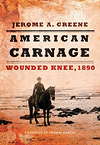
American Carnage: Wounded Knee, 1890, by Jerome A. Greene, University of Oklahoma Press, Norman, 2014, $34.95
The Indian wars of the mid- to late-19th century came during a period of extraordinary population dynamics on this continent as wagon trainloads of mostly white pioneers pressed Indian tribes on the Great Plains into ever-closer proximity. What followed was an inevitably human cycle of competition for land and resources, conflict, treaties, renewed migration, broken treaties and further violence. Marking the period were battles (Rosebud, Little Bighorn), massacres (Sand Creek, Marias) and clashes that combined elements of legitimate frontier combat and indiscriminate killing. The November 27, 1868, fight on the Washita River (subject of a 2004 book by author Jerome Greene) falls into the latter category, as does the December 29, 1890, South Dakota clash on Wounded Knee Creek, alternately termed a “battle,” “incident” or “massacre.”
In the most even-handed account yet of an event too often inflamed into hyperbole—most notably by Dee Brown in his 1970 book Bury My Heart at Wounded Knee—author and former National Park Service historian Greene has diligently researched primary sources from both sides of the conflict to produce a scholarly yet engaging narrative of the precursors, actions and aftermath of an ultimately tragic encounter. Greene does a thorough job of outlining the tangible and intangible causes (ongoing conflict, drought, starvation, the botched arrest and killing of Sitting Bull, Ghost Dance superstition, mutual suspicion and plain hatred) that drew the 7th U.S. Cavalry and a band of Lakota Sioux into conflict in late 1890.
After fleeing south with his band from the troubled Cheyenne River Agency in central South Dakota, Minneconjou Lakota Chief Big Foot had accepted Chief Red Cloud’s invitation to shelter at the Pine Ridge Agency. He was en route when intercepted on December 28 by a 7th Cavalry battalion under Major Samuel Whitside and escorted to the banks of Wounded Knee Creek. Colonel James Forsyth and the rest of the 7th arrived later that evening, bringing the number of troopers to 472, arrayed against Big Foot’s camp of 370 people, 120 of whom were warriors. Taking no chances, Forsyth cordoned off the Indian camp and placed a battery of four rapid-fire Hotchkiss guns on an overlooking ridge.
Early the next morning, December 29, Forsyth ordered the Lakotas to surrender their weapons and prepare for removal by waiting railcars to an Omaha reservation. After receiving a few worthless “blunderbusses” and finding only a few dozen equally shabby guns in a subsequent search, an exasperated Forsyth ordered a man-by-man pat-down of Big Foot’s warriors. As a small party of soldiers stepped forward to begin the search, a medicine man among the Lakotas launched into the demonstrative rituals of the Ghost Dance and urged the warriors to defiance.
“In a flash all was tumult,” writes Greene. “What happened next took but seconds but would mark memory and history forever. A single gunshot pierced the air.” Warriors cast aside blankets, raised lever-action Winchesters and fired on the soldiers, some two dozen of whom fell dead or wounded. Other Indians ran for the pile of confiscated firearms as the soldiers returned fire in “one deafening crash.” For at least the first seven or eight minutes, Wounded Knee was most assuredly a battle.
In the middle ground between combat and carnage is a realm governed by the “fog of war.” That fog is in part literal, in this case, Greene writes, in the form of “dense rolling smoke, blankets and other garments [that] combined to obfuscate distinctions between men and women, old and young, and even animals.”
But that fog also includes the aspect of violence that taps into man’s elemental emotions, in a moment replacing discipline with frenzy, restraint with bloodlust. “No single officer exercised control,” Greene says of that moment at Wounded Knee, “and the shooting momentarily escalated as all personal constraint and self-possession fell away.” What followed was indeed a massacre, as soldiers shot at anything that moved and the Hotchkiss gunners “unleashed a barrage of shrieking canister that shredded tipis and improvised shelters, extinguishing whatever life remained in the camp area.” The pursuit that followed was a merciless slaughter that targeted all living Lakotas, regardless of combatant status, gender or age. When the shooting finally stopped, some 200 of Big Foot’s band—men, women and children—lay dead. Now-familiar photographs, taken in the days that followed, show workers collecting grotesquely frozen corpses for burial in mass graves.
“The larger question of why it happened at all will probably remain unresolved,” concedes Greene. “It likely could have been avoided with improved communication and greater tolerance and patience all around, unfamiliar concepts at the time when the government sought to impress its control over tribal populations.” American Carnage adds appreciably to our understanding of Wounded Knee. Perhaps it will also bridge any remaining gaps in our understanding and tolerance of one another.
—Dave Lauterborn




